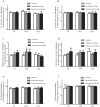Intestinal microbiota succession and immunomodulatory consequences after introduction of Lactobacillus reuteri I5007 in neonatal piglets
- PMID: 25775260
- PMCID: PMC4361599
- DOI: 10.1371/journal.pone.0119505
Intestinal microbiota succession and immunomodulatory consequences after introduction of Lactobacillus reuteri I5007 in neonatal piglets
Abstract
Seventy-two, suckling piglets, obtained from 9 litters standardized to 8 piglets, were assigned to 1 of 3 treatments (n = 24) to compare short-term, early administration with intermittent, longer-term administration of Lactobacillus reuteri I5007. The treatments were a control (given a placebo of 0.1% peptone water from day 1 to 5) or treatments in which 1.7 × 1010 CFU L. reuteri was administrated either daily for 4 days starting on day 1 or every 4th day from day 1 to 17. Five piglets per treatment were killed at 3 time points (day 7, 14 and 21). Denaturing Gradient Electrophoresis of ileal digesta revealed an increase in the presence of L. reuteri I5007 and Clostridium lentocellum (on day 14 and 21) in the every 4th-day treatment and Actinobacillus porcinus (on day 7 and 14) in both L. reuteri treatments, while reducing the abundance of E. coli on day 21 in the every 4th-day treatment. Real-time qPCR of ileal digesta showed an increase in Bifidobacterium spp. on day 14 for both L. reuteri I5007 treatments. An increase in the concentration of lactic acid and a lower pH was observed in the first 4-day treatment on day 7 and the every 4th day treatment on day 14. The relative abundance of mRNA for TGF-β was increased while that for IFN-γ was decreased in the mesenteric lymph nodes of piglets treated with L. reuteri every 4th day. In conclusion, early intervention with L. reuteri increases the presence of beneficial bacteria and decreases the presence of undesirable microbes in the lower gastrointestinal tract. The changes appear to be mediated by altering the intestinal pH through lactic acid production resulting in favorable bacterial species colonization. A prolonged duration of treatment (i.e. every 4th day) would appear to be superior to treatment only during the first 4 days.
Conflict of interest statement
Figures




References
-
- Bailey M, Haverson K, Inman C, Harris C, Jones P, Corfield G, et al. The development of the mucosal immune system pre- and post-weaning: balancing regulatory and effector function. Proc Nutr Soc. 2005; 64: 451–457. - PubMed
-
- Bauer E, Williams BA, Smidt H, Verstegen MW, Mosenthin R. Influence of the gastrointestinal microbiota on development of the immune system in young animals. Curr Issues Intest Microbiol. 2006; 7: 35–51. - PubMed
Publication types
MeSH terms
Substances
LinkOut - more resources
Full Text Sources
Other Literature Sources
Molecular Biology Databases
Miscellaneous

